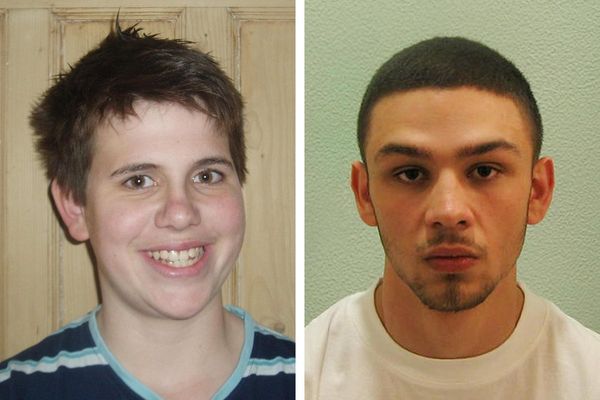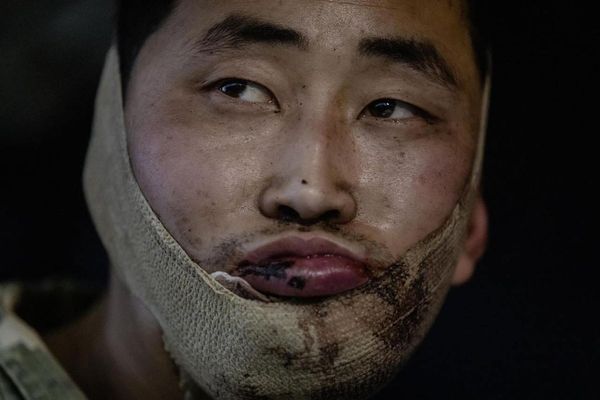
Updated at 2:55 p.m. on May 10, 2022
In the two years since she caught the coronavirus, 38-year-old Jessica McGovern has cycled through “well over 100 drugs, supplements, and therapies” to try to keep her long-COVID symptoms at bay. In almost all cases, she told me, the interventions were to no avail: Exhaustion, weakness, and aches still lashed her to the couch; she still felt suffocating chest pain that worsened when she inhaled; her upper body was still haunted by a sharp, staticky sensation that reminded her of running hot water over frozen hands. McGovern would fall asleep in agony, then dream of more agony.
Then, around the start of April, she began a five-day course of Paxlovid, Pfizer’s antiviral pill. By her second day on the drug, McGovern “could feel the messaging in my body shifting.” Four weeks later, her fatigue, aches, and labored breathing remain. But the screaming, nerves-on-fire pain that gripped her body for two dozen months “is basically gone,” she told me. She’s recovered some mobility. She’s spending more time with her three young kids. A flutist for nearly three decades, she’s playing her instrument again after a two-year hiatus, “which feels incredible,” like reclaiming a shade of her former self.
To date, no established treatments exist for long COVID. But in recent weeks, a smattering of long-haulers—McGovern among them—have been surprised to feel their sicknesses subside after taking Pfizer’s new drug. The case for treating long COVID with antivirals is far from open-and-shut. But should these anecdotal reports augur a flood of similar data, Paxlovid might offer a surprisingly straightforward fix to one of the pandemic’s biggest puzzles. Long COVID is so ranging, so diverse, so capable of wreaking havoc on a multitude of tissues that treatment, for many, will undoubtedly require the rehabilitation of many bodily systems at once. Maybe, though, for a subset of long-haulers, a few days of antiviral pills could be all it takes to rev the healing process into gear.
[Read: The pandemic after the pandemic]
That Paxlovid may quench anyone’s long-COVID symptoms is itself a bit mysterious: The drug works best when delivered fast and early, futzing with the virus’s ability to xerox itself inside human cells and making it easier for the immune system to jettison the bug. But long COVID can take weeks or months to manifest, and hasn’t been proven to have a persistent viral source. Experts still don’t know how common, or lasting, post-pill reprieves might be; they can’t say with confidence why the drug could have palliative effects, or—if said effects are substantiated—which long-haulers stand to benefit most.
Even in the rosiest scenario, Paxlovid won’t be a panacea. But if it has a chance of doing something, even for just a fraction of long-haulers, “we have to at least try,” says Jeanne Marrazzo, the director of the division of infectious diseases at the University of Alabama at Birmingham School of Medicine, “because we have nothing else.” Millions of people in the United States alone are estimated to have developed long COVID’s harrowing symptoms since the pandemic’s start; their numbers grow with each additional wave. “This is an intervention that should [have been] under clinical trial yesterday,” says David Putrino, a neuroscientist and rehabilitation specialist at Mount Sinai. And yet there are, to date, no well-designed studies investigating Paxlovid’s potential as a long-COVID drug, and none publicly poised to begin.
The search for long-COVID therapies has been stymied, in part, by the nature of long COVID. The condition, like cancer, appears to be not a single disease but a category of related-but-distinct syndromes, each of which could manifest with its own set of symptoms, require its own treatments, and stem from a slightly different cause. In some proportion of long-haulers, maybe the majority, the virus is believed to have come and gone, leaving behind physiological devastation—battered tissues, raging inflammation, self-attacking antibodies, discombobulated nerves, a freckling of blood clots. In these cases, experts told me, Paxlovid probably won’t do diddly-squat. But perhaps the drug could help another group of long-haulers, who are thought to harbor hard-to-reach reservoirs of virus that regularly rile the body up.
The snarl is that no one has yet provided slam-dunk evidence of these hidden viral caches. Many scientists, including Yale’s Akiko Iwasaki, one of the world’s top long-COVID researchers, argue that strong hints are there: SARS-CoV-2 certainly can stick around in certain people’s bodies for months, and can also mosey out of the airway to colonize other tissues, including ones that certain immune fighters can’t easily access. Researchers have seen traces of the virus’s genetic material and proteins in a mélange of organs, sometimes months after infections begin. But while those fragments could represent active virus, they could also be bits of stray microbial trash. To help clinch the case, researchers would have to recruit tons of long-haulers, guess where the virus might be lurking, and see if they could extract enough of the microbe from that tissue to infect new cells in the lab—studies that are invasive, “long and slow and painful” to get just right, and couldn’t even prove that the virus was causing the symptoms at hand, says Catherine Blish, an immunologist at Stanford.
Still, Vineet Menachery, a coronavirus expert at the University of Texas Medical Branch, believes long-term infection is probably “more common than we think,” he told me. People’s lived experiences support that too. Some long-haulers have reported feeling a massive, unexpected upswing in well-being after receiving COVID vaccines—a trend several experts attribute to the shots galvanizing immune cells into finally, finally kicking out remnant virus.
The handful of post-Paxlovid improvement stories now emerging echo what other long-haulers felt with the vaccines. A group of Stanford researchers, led by the physician Linda Geng, recently reported that a 47-year-old woman’s long-COVID symptoms—among them, fatigue, insomnia, body aches, cognitive issues, and a racing heartbeat—evaporated after she took Paxlovid for a possible reinfection. “She was able to go back to work, and started exercising again,” Geng told me. A couple of long-haulers being treated at a clinic at UCSF may be on a similar trajectory. Lavanya Visvabharathy, a 37-year-old immunologist at Northwestern University, experienced a bounceback as well. After months of headaches, fatigue, and disturbed sleep, she nabbed Paxlovid at the end of March, and “all my symptoms went away,” she told me. Visvabharathy, who takes immunosuppressive drugs to manage her rheumatoid arthritis, had been repeatedly testing antigen-positive. But after she finished Pfizer’s pills, she saw a negative for the first time since she was infected, in December.
Anecdotes and case studies alone won’t be enough. So far, the reports of post-Paxlovid improvements have been too inconsistent, too scant “to gauge what’s really happening,” Angela Meriquez Vázquez, who runs Body Politic, an advocacy group that offers support to people with long COVID, told me. Many long-haulers do not qualify to take Paxlovid, because they haven’t recently tested positive and are not considered at “high risk” of developing severe COVID. Long COVID’s symptoms can also naturally wax and wane, making it difficult to tie relief to a definitive cause. To show with any real clarity whether Paxlovid’s doing what many long-haulers hope, someone needs to test the theory with rigorous clinical trials, ideally with the help of the company that’s manufacturing the drug.
Pfizer doesn’t seem actively opposed. The company is “considering how we would potentially study it,” Kit Longley, a spokesperson for Pfizer, wrote in an email, but declined to clarify why the company has no study under way. That frustrates Putrino, of Mount Sinai, who thinks Pfizer will need to spearhead many of these efforts; it’s Pfizer’s drug, after all, and the company has the best data on it, and the means to move it forward. The NIH, whose RECOVER initiative has a budget of more than $1 billion to study long COVID, recently sought proposals for clinical trials of new long-COVID therapies, including, potentially, antivirals—a promising step, Stanford’s Geng told me. But the agency has been sharply criticized for dillydallying in the year-plus since the program launched, and for de-emphasizing treatment-focused trials. And there’s no guarantee that Paxlovid will be among the treatments tested. When asked to elaborate on Paxlovid’s experimental status, the NIH said only that the agency “is very interested in long term viral activity as a potential cause of PASC (long COVID), and antivirals such as Paxlovid are in the class of treatments being considered for the clinical trials.”
In all fairness, a Paxlovid–long-COVID trial would be tough. Researchers still haven’t reached a consensus on how to define or diagnose long COVID, or what it means for patients to markedly improve. Drugs against severe disease have an ultra-clear readout: “You count the number of people who end up in the hospital,” says Steven Deeks, a long-COVID researcher at UCSF. Long COVID’s sprawling scope, however, means no single ruler can measure the drug’s potential impact. Many of the experts I spoke with felt a bit daunted by the idea of trying to quantify the disease’s qualitative symptoms pre- and post-Paxlovid. That challenge, they said, could be a stumbling block for any research effort. But JD Davids, the co-founder of the Strategies for High Impact and its National Network for Long COVID Justice, who has long COVID, told me scientists don’t have to look far for inspiration. Researchers have already developed metrics for another chronic illness, ME/CFS (which Davids also has) to rate, for instance, the severity of fatigue, mobility limitations, and pain. “You just have to believe that people can tell you how they are feeling,” Davids said.
[Read: Long-haulers are fighting for their future]
Then there’s the question of whom to enroll, and how many of them. If only a small fraction of long-haulers are duking it out with persistent virus, “you might not see the benefit” in trials, unless they’re gargantuan in size, says Daniel Griffin, an infectious-disease physician at Columbia. Researchers could hedge their bets by selectively recruiting long-haulers who continually shed bits of virus genetic material in their feces, say, or who only recently developed long-COVID symptoms and might be more likely to have SARS-CoV-2 still inside them. But select the wrong subset, and a trial could tank. Iwasaki, of Yale, wants to explicitly study the drug’s effects in a wide range of people. “The goal is not to cure everyone but understand who benefits,” she told me—and when. In some people, long COVID could evolve from a viral problem into an autoimmune one, making early intervention essential.
Paxlovid has baggage too. In recent weeks, some people taking the five-day pill course for new infections have reported a rebound in symptoms and test positivity—a likely indication, UTMB’s Menachery told me, that the pills aren’t sweeping all the SARS-CoV-2 out. It’s still unclear how common the relapses are, and the problem may be cropping up with long COVID too. Alisa Valdes, a 53-year-old writer who has battled more than 220 long-COVID symptoms, “felt normal for the first time in 25 months” after taking Paxlovid in April. “I was skipping, I was jumping,” she told me. “I thought, This is a miracle.” But within a day of the drugs running out, her body was once again aching, feverish, and inflamed; angry red rashes that had disappeared came roaring right back.
Visvabharathy, the Northwestern immunologist, told me that a few weeks after taking Paxlovid, she felt some symptoms creeping back as well. A test she took at the end of April also came up positive. Perhaps Paxlovid’s five-day regimen for acute COVID will need to be lengthened in some newly infected patients; long-haulers may require something more extended still. Such a tweak could prompt a slew of safety questions. The original clinical trials turned up side effects—occasional bouts of diarrhea, a nasty sour tang in the mouth—that did not raise huge concerns, but after months of unabating illness, long-haulers’ bodies may not react in the same way to the drugs, especially when dosed on an extra-long course. Paxlovid also interferes with a hefty list of other medications, some of which can’t be paused for extended periods.
[Read: Paxlovid mouth is real—and gross]
Right now, long-haulers are gambling with all of those question marks as they seek the drug out—some of them through loopholes in the health-care system, with the help of providers sympathetic to their cause. With so few options on the table, people are “itching for any type of treatment,” Body Politic’s Vázquez told me, and some are willing to stomach a bit of risk. But in the absence of real data and rigorous research, and with so many unable to access the drug at all, others are hesitant and confused—and afraid of being once again let down.
From the start of the pandemic, skepticism has dogged long COVID and the people who live with it. McGovern, the flutist, spent much of 2020 being repeatedly told that her symptoms were just anxiety, or that she was feeling off because she was allergic to her pet parrots. (She is not.) Attitudes have improved in the years since—but some doctors, once unsure of long COVID’s existence, now struggle to wrap their head around the prospect of out-of-the-box treatments. At one point, I asked McGovern which of the many therapies she’s tried actually helped. “Aside from my family and close friends, you’re the first person to ask me that,” she told me. “I’ve never had a physician ask me ‘What has worked for you?’”
This skepticism can extend to research too. Benjamin tenOever, a virologist at NYU, told me that he recently had NIH funding pulled from a project that would have investigated whether antivirals could combat long-COVID symptoms in a hamster model. His contact at the agency said the study had “no merit,” tenOever told me. “They were like, This doesn’t make sense, because why would Paxlovid ever help long COVID? The virus is long gone.” (When I reached out to NIH, Clint Wright, the director of the Division of Clinical Research at the National Institute of Neurological Disorders and Stroke, responded that “we can’t comment on research that is not funded.”) Others posited that the possible benefit of antivirals for long-haulers might not feel worth the effort required to prove it: Even if viral persistence plays a role, it may be quite uncommon. Yale’s Iwasaki dismisses this. “Say it’s only 10 percent of patients that respond positively,” she told me. That’s still potentially millions of people in the U.S. alone.
America’s neglectful posture on long COVID is choreographed into just about every aspect of what’s left of the country’s pandemic response. Vaccines can’t totally block long COVID, but are being billed, via boosters, as one of the only interventions people need; the CDC’s newest guidelines on masks almost entirely elide the condition’s existence, as it’s not classically considered to be clinically “severe.” Researchers aren’t even sure if early-acting treatments such as antivirals slash people’s chances of getting long COVID, though Iwasaki is hopeful that they do. With so few protections against long COVID available or in use, its burden only stands to grow. Therapies, at least, could finally construct an exit ramp.
Paxlovid could still be a bust. But the process of figuring that out could shift the landscape for long COVID. Carefully testing this drug in long-haulers could help researchers build templates for even more clinical trials, Davids, of the National Network for Long COVID Justice, told me. And perhaps other, more powerful therapies would follow: antivirals specifically tailored for long-haulers’ needs, or immune-modulating drugs to combat the cases of long COVID that are less about the virus and more about the body attacking itself. Long COVID’s problem has always been a self-reinforcing one. It is difficult to address, so it goes unaddressed; countries do not know how to deal with it, so they don’t, and simply never learn. Reversing that trend, Davids and other long-haulers told me, means not just describing the condition but tackling it; not just counting the people who live with it but working to reduce their ranks. The world has to start that process now, or risk falling further behind.







